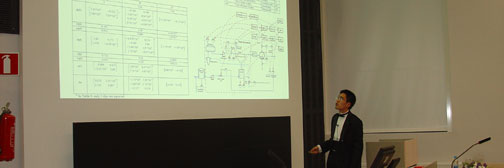Year 2014
Topi Elmeri WaljusAmmoniakin talteenotto hapanvesiyksik�iden prosessivirroista
As environmental regulations become tighter the reduction of sulfur dioxide and other emissions has become increasingly important for the oil refining industry. In the process of refining crude oil acid gas that consists of hydrogen sulfide and ammonia is produced. Traditionally, this gas is treated in a Claus process where hydrogen sulfide is oxidized into elemental sulfur and ammonia into nitrogen. Ammonia however creates indirect disturbances to the Claus process as it may produce salts that foul and plug the system. The goal of the thesis was to gather information about ammonia recovery from sour water units' process flows.
In the thesis the effect of ammonia in sulfur recovery is introduced and information about environmental regulations and control strategies are discussed. The process environment where the ammonia would be to recover from is observed and different methods for ammonia removal are introduced. These methods are compared with one another and ammonium thiosulfate processes are observed in detail.
Later in the work the balance of one ammonium thiosulfate process is calculated and it has been simulated with Aspen Plus V8.4 simulation program with the initial values from the process environment. The goal was to produce a control strategy for an ammonium thiosulfate process that would eventually consume all the ammonia fed to the process and produce at least 60 w-96 ammonium thiosulfate solution. With the aid of the remarks gathered from the simulation it was possible to introduce control strategy for the changes in capacity, the quality of the product and the gas emissions produced by the simulated process.
From the data gathered from the simulation it is possible to mention that the simulated ammonium thiosulfate process is an effective method for ammonia recovery and additionally it increases the sulfur processing capacity of the oil refinery.
Thesis electronical version can be downloaded from here
This info last modified 27 Apr 2024 by Jukka Kortela
| 
